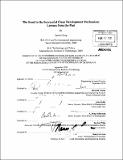| dc.contributor.advisor | John Reilly. | en_US |
| dc.contributor.author | Song, Jaemin | en_US |
| dc.contributor.other | Massachusetts Institute of Technology. Engineering Systems Division. | en_US |
| dc.date.accessioned | 2011-05-09T15:31:54Z | |
| dc.date.available | 2011-05-09T15:31:54Z | |
| dc.date.copyright | 2010 | en_US |
| dc.date.issued | 2010 | en_US |
| dc.identifier.uri | http://hdl.handle.net/1721.1/62763 | |
| dc.description | Thesis (Ph. D.)--Massachusetts Institute of Technology, Engineering Systems Division, 2010. | en_US |
| dc.description | Cataloged from PDF version of thesis. | en_US |
| dc.description | Includes bibliographical references. | en_US |
| dc.description.abstract | The Clean Development Mechanism (CDM) has evolved at a surprising speed since 2003 and is considered to have made positive contributions to the development of greenhouse-gas-reducing projects in developing countries. Taking into account its historical significance as the first effort of its kind and its current success, a thorough evaluation of its system and its effectiveness is of critical importance. Against this backdrop, this study closely investigates each stage of the CDM project cycle from development and registration of projects to issuance of certified emission reductions and identifies influential factors for the successful CDM implementation. For the analysis, we performed an extensive quantitative analysis augmented by a descriptive study, based on information of approximately 5000 CDM project. Our findings suggest that the development of CDM projects is stimulated by favorable economic, social and technical environments in host countries as well as supportive CDM administration. This explains why projects are currently concentrated in certain countries such as China and India. Once projects are developed and submitted for validation, the success of the CDM projects at the next stages of project cycle related to registration and Certified Emission Reduction (CER) issuance is influenced by their types and a choice of Designated Operational Entities and project consultants. In particular, significant difference in registration success exists across project types, which calls for special attention of both the CDM authority and project participants to projects with high risks like energy efficiency, fossil fuel switch and biomass projects. Lastly, we found that performance of projects is affected by very project-specific conditions. For many of the most poorly performing projects, failure is attributable to technical and operational problems at the initial stage of project implementation, which highlights the importance of well-prepared PDDs. Based on the findings, the thesis concludes with policy recommendations to enhance the capacities and improve the performance of the major players under the CDM. | en_US |
| dc.description.statementofresponsibility | by Jaemin Song. | en_US |
| dc.format.extent | 146 p. | en_US |
| dc.language.iso | eng | en_US |
| dc.publisher | Massachusetts Institute of Technology | en_US |
| dc.rights | M.I.T. theses are protected by
copyright. They may be viewed from this source for any purpose, but
reproduction or distribution in any format is prohibited without written
permission. See provided URL for inquiries about permission. | en_US |
| dc.rights.uri | http://dspace.mit.edu/handle/1721.1/7582 | en_US |
| dc.subject | Engineering Systems Division. | en_US |
| dc.title | The road to the successful clean development mechanism : lessons from the past | en_US |
| dc.type | Thesis | en_US |
| dc.description.degree | Ph.D. | en_US |
| dc.contributor.department | Massachusetts Institute of Technology. Engineering Systems Division | |
| dc.identifier.oclc | 718628006 | en_US |
